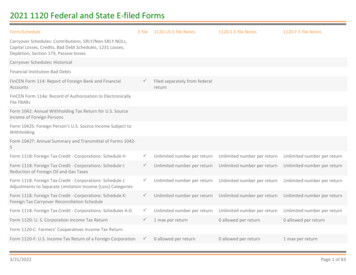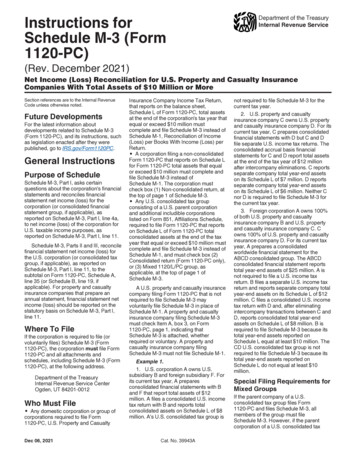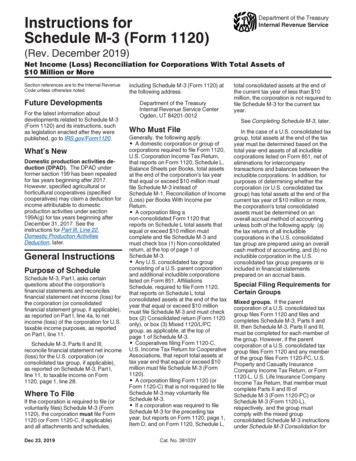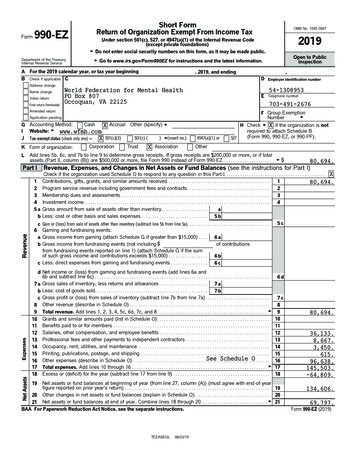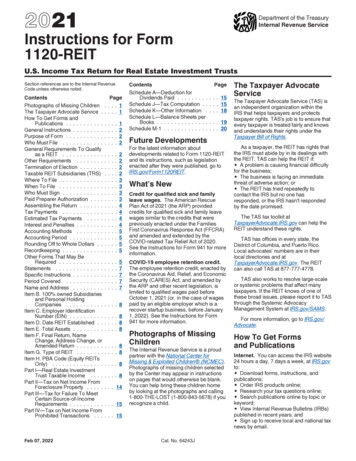
Transcription
2021Department of the TreasuryInternal Revenue ServiceInstructions for Form1120-REITU.S. Income Tax Return for Real Estate Investment TrustsSection references are to the Internal RevenueCode unless otherwise noted.ContentsPhotographs of Missing ChildrenThe Taxpayer Advocate Service .How To Get Forms andPublications . . . . . . . . . . .General Instructions . . . . . . . . .Purpose of Form . . . . . . . . . . .Who Must File . . . . . . . . . . . .General Requirements To Qualifyas a REIT . . . . . . . . . . . .Other Requirements . . . . . . . .Termination of Election . . . . . . .Taxable REIT Subsidiaries (TRS)Where To File . . . . . . . . . . . . .When To File . . . . . . . . . . . . .Who Must Sign . . . . . . . . . . . .Paid Preparer Authorization . . . .Assembling the Return . . . . . . .Tax Payments . . . . . . . . . . . .Estimated Tax Payments . . . . .Interest and Penalties . . . . . . . .Accounting Methods . . . . . . . .Accounting Period . . . . . . . . . .Rounding Off to Whole Dollars . .Recordkeeping . . . . . . . . . . . .Other Forms That May BeRequired . . . . . . . . . . . . .Statements . . . . . . . . . . . . . .Specific Instructions . . . . . . . . .Period Covered . . . . . . . . . . .Name and Address . . . . . . . . .Item B. 100% owned Subsidiariesand Personal HoldingCompanies . . . . . . . . . . .Item C. Employer IdentificationNumber (EIN) . . . . . . . . . .Item D. Date REIT Established . .Item E. Total Assets . . . . . . . . .Item F. Final Return, NameChange, Address Change, orAmended Return . . . . . . . .Item G. Type of REIT . . . . . . . .Item H. PBA Code (Equity REITsOnly) . . . . . . . . . . . . . . .Part I—Real Estate InvestmentTrust Taxable Income . . . .Part II—Tax on Net Income FromForeclosure Property . . . . .Part III—Tax for Failure To MeetCertain Source-of-IncomeRequirements . . . . . . . . . .Part IV—Tax on Net Income FromProhibited Transactions . . .Feb 07, 2022Page. 1. 1.1222.2222333344445555.57777. 8. 8. 8. 8. 8. 8. 8. 8. . . 14. . . 15ContentsSchedule A—Deduction forDividends Paid . . . . . . . . .Schedule J—Tax Computation . .Schedule K—Other Information .Schedule L—Balance Sheets perBooks . . . . . . . . . . . . . . .Schedule M-1 . . . . . . . . . . . . .Page. . . 15. . . 15. . . 18. . . 19. . . 20Future DevelopmentsFor the latest information aboutdevelopments related to Form 1120-REITand its instructions, such as legislationenacted after they were published, go toIRS.gov/Form1120REIT.What’s NewCredit for qualified sick and familyleave wages. The American RescuePlan Act of 2021 (the ARP) providedcredits for qualified sick and family leavewages similar to the credits that werepreviously enacted under the FamiliesFirst Coronavirus Response Act (FFCRA)and amended and extended by theCOVID-related Tax Relief Act of 2020.See the Instructions for Form 941 for moreinformation.COVID-19 employee retention credit.The employee retention credit, enacted bythe Coronavirus Aid, Relief, and EconomicSecurity (CARES) Act, and amended bythe ARP and other recent legislation, islimited to qualified wages paid beforeOctober 1, 2021 (or, in the case of wagespaid by an eligible employer which is arecover startup business, before January1, 2022). See the Instructions for Form941 for more information.Photographs of MissingChildrenThe Internal Revenue Service is a proudpartner with the National Center forMissing & Exploited Children (NCMEC).Photographs of missing children selectedby the Center may appear in instructionson pages that would otherwise be blank.You can help bring these children homeby looking at the photographs and calling1-800-THE-LOST (1-800-843-5678) if yourecognize a child. . . 15Cat. No. 64243JThe Taxpayer AdvocateServiceThe Taxpayer Advocate Service (TAS) isan independent organization within theIRS that helps taxpayers and protectstaxpayer rights. TAS's job is to ensure thatevery taxpayer is treated fairly and knowsand understands their rights under theTaxpayer Bill of Rights.As a taxpayer, the REIT has rights thatthe IRS must abide by in its dealings withthe REIT. TAS can help the REIT if: A problem is causing financial difficultyfor the business; The business is facing an immediatethreat of adverse action; or The REIT has tried repeatedly tocontact the IRS but no one hasresponded, or the IRS hasn't respondedby the date promised.The TAS tax toolkit atTaxpayerAdvocate.IRS.gov can help theREIT understand these rights.TAS has offices in every state, theDistrict of Columbia, and Puerto Rico.Local advocates' numbers are in theirlocal directories and atTaxpayerAdvocate.IRS.gov. The REITcan also call TAS at 877-777-4778.TAS also works to resolve large-scaleor systemic problems that affect manytaxpayers. If the REIT knows of one ofthese broad issues, please report it to TASthrough the Systemic AdvocacyManagement System at IRS.gov/SAMS.For more information, go to IRS.gov/Advocate.How To Get Formsand PublicationsInternet. You can access the IRS website24 hours a day, 7 days a week, at IRS.govto: Download forms, instructions, andpublications; Order IRS products online; Research your tax questions online; Search publications online by topic orkeyword; View Internal Revenue Bulletins (IRBs)published in recent years; and Sign up to receive local and national taxnews by email.
Tax forms and publications. The REITcan download or print all of the forms andpublications it may need at IRS.gov/FormsPubs.Otherwise, the REIT can go to IRS.gov/OrderForms to place an order and haveforms mailed to it. The IRS will processyour order for forms and publications assoon as possible.General InstructionsPurpose of FormUse Form 1120-REIT, U.S. Income TaxReturn for Real Estate Investment Trusts,to report the income, gains, losses,deductions, credits, certain penalties, andto figure the income tax liability of a REIT.Who Must FileA corporation, trust, or association thatmeets certain conditions (discussedbelow) must file Form 1120-REIT if itelects to be treated as a REIT for the taxyear (or has made that election for a priortax year and the election has not beenterminated or revoked). The election ismade by figuring taxable income as aREIT on Form 1120-REIT.Qualified opportunity funds. To becertified as a qualified opportunity fund,the corporation must file Form 1120-REITand attach Form 8996, even if thecorporation had no income or expenses toreport. See Schedule K, Question 12,later. Also, see the Instructions for Form8996.General Requirements ToQualify as a REITTo qualify as a REIT, an organization: Must be a corporation, trust, orassociation. Must be managed by one or moretrustees or directors. Must have beneficial ownership (a)evidenced by transferable shares, or bytransferable certificates of beneficialinterest; and (b) held by 100 or morepersons. (The REIT does not have to meetthis requirement until its 2nd tax year.) Would otherwise be taxed as adomestic corporation. Must be neither a financial institution(referred to in section 582(c)(2)), nor asubchapter L insurance company. Cannot be closely held, as defined insection 856(h). (The REIT does not haveto meet this requirement until its 2nd taxyear.)If a REIT meets the requirement forascertaining actual ownership (seeRegulations section 1.857-8 for details),and did not know (after exercisingreasonable diligence), or have reason toknow, that it was closely held, it will betreated as meeting the requirement that itis not closely held.Other RequirementsThe gross income and diversification ofinvestment requirements of section 856(c)must be met and the organization must: Have been treated as a REIT for all taxyears beginning after February 28, 1986,or Had, at the end of the tax year, noaccumulated earnings and profits fromany tax year that it was not a REIT.For this purpose, distributions aretreated as made from the earliest earningsand profits accumulated in any non-REITtax year. See section 857(d)(3). The organization must adopt a calendartax year unless it first qualified for REITstatus before October 5, 1976. The deduction for dividends paid(excluding net capital gain dividends, ifany) must equal or exceed:1. 90% of the REIT's taxable income(excluding the deduction for dividendspaid and any net capital gain), plus2. 90% of the excess of the REIT's netincome from foreclosure property over thetax imposed on that income by section857(b)(4)(A); less3. Any excess noncash income asdetermined under section 857(e).See sections 856 and 857, and therelated regulations for details andexceptions.Termination of ElectionThe election to be treated as a REITremains in effect until terminated, revoked,or the REIT has failed to meet therequirements of the statutory reliefprovisions. It terminates automatically forany tax year in which the corporation,trust, or association is not a qualifiedREIT.The organization may revoke theelection for any tax year after the 1st taxyear the election is effective by filing astatement with the service center where itfiles its income tax return. The statementmust be filed on or before the 90th dayafter the 1st day of the tax year for whichthe revocation is to be effective. Thestatement must include the following: The name, address, and employeridentification number (EIN) of theorganization; The tax year for which the election wasmade; A statement that the organization(according to section 856(g)(2)) revokesits election under section 856(c)(1) to be aREIT; and The signature of an official authorizedto sign the income tax return of theorganization.-2-The organization may not make a newelection to be taxed as a REIT during the 4years following the 1st year for which thetermination or revocation is effective. Seesection 856(g)(4) for exceptions.Taxable REIT Subsidiaries(TRS)A REIT may own up to 100% of the stockin one or more taxable REIT subsidiaries(TRS). A TRS must be a corporation(other than a REIT or a qualified REITsubsidiary) and may provide services tothe REIT's tenants without disqualifyingthe rent received by the REIT. See section856(l) for details, including certainrestrictions on the type of businessactivities a TRS may perform. Also, notmore than 20% of the fair market value(FMV) of a REIT's total assets (25% for taxyears beginning after July 30, 2008, andno later than December 31, 2017) may besecurities of one or more TRSs (seesection 856(c)(4) for details).Transactions between a TRS and itsassociated REIT must be at arm's length.A REIT may be subject to a 100% tax tothe extent it improperly allocates incomeand deductions between the REIT and theTRS (see section 857(b)(7) for details).Additional limitations on transactionsbetween a TRS and its associated REITinclude: Limitations on income from a TRS thatmay be treated as rents from real propertyby the REIT (see section 856(d)(8)), and Limitations on a TRS's deduction forinterest paid to its associated REIT (seesection 163(j)).To elect to have an eligible corporationtreated as a TRS, the corporation and theREIT must jointly file Form 8875, TaxableREIT Subsidiary Election.Restrictions on tax-free spinoffs fromREITs. For distributions after December6, 2015, a REIT is generally ineligible toparticipate in a tax-free spinoff as either adistributing or controlled corporation undersection 355. This general rule does notapply if both the distributing corporationand the controlled corporation are REITsimmediately after the distribution. Also, aREIT may spin off a TRS if the followingapply. The distributing corporation has been aREIT at all times during the 3-year periodending on the date of distribution; The controlled corporation has been aTRS of the REIT at all times during suchperiod; and The REIT has had control (as defined insection 368(c) applied by taking intoaccount stock owned, directly andindirectly, including through partnerships,by the REIT) of the TRS at all times duringsuch period.A controlled corporation is treated asmeeting the control requirements if the
stock of the corporation was distributed bya TRS in a transaction to which section355 applies and the assets of thecorporation consist solely of the stock orassets held by one or more TRSs of thedistributing corporation meeting thecontrol requirements described above.If a corporation that is not a REIT was adistributing or controlled corporation withrespect to any distribution to which section355 applied, the corporation will not beeligible to make a REIT election for any taxyear beginning before the end of the10-year period beginning on the date ofsuch distribution.See sections 355(h) and 856(c)(8) formore details.When To FileGenerally, a REIT must file its income taxreturn by the 15th day of the 4th monthafter the end of its tax year. A new REITfiling a short period return must generallyfile by the 15th day of the 4th month afterthe short period ends. A REIT that hasdissolved must generally file by the 15thday of the 4th month after the date itdissolved.However, a REIT with a fiscal tax yearending June 30 must file by the 15th dayof the 3rd month after the end of its taxyear. A REIT with a short tax year endinganytime in June will be treated as if theshort year ended on June 30, and must fileby the 15th day of the 3rd month after theend of its tax year.If the due date falls on a Saturday,Sunday, or legal holiday, the REIT can fileon the next business day.Private Delivery ServicesThe REIT can use certain private deliveryservices (PDS) designated by the IRS tomeet the “timely mailing as timely filing”rule for tax returns. Go to IRS.gov/PDS forthe current list of designated services.The PDS can tell you how to get writtenproof of the mailing date.For the IRS mailing address to use ifyou're using a PDS, go to IRS.gov/PDSStreetAddresses.Private delivery services can'tdeliver items to P.O. boxes. YouCAUTION must use the U.S. Postal Serviceto mail any item to an IRS P.O. boxaddress.!Extension of Time To FileFile Form 7004, Application for AutomaticExtension of Time To File CertainBusiness Income Tax, Information, andOther Returns, to request an extension oftime to file. Generally, file Form 7004 bythe regular due date of the REIT's incometax return. See the Instructions for Form7004 for more information.Who Must SignThe return must be signed and dated by: The president, vice president, treasurer,assistant treasurer, chief accountingofficer; or Any other corporate officer (such as atax officer) authorized to sign.If a return is filed on behalf of a REIT bya receiver, trustee, or assignee, thefiduciary must sign the return, instead ofthe corporate officer. Returns and formssigned by a receiver or trustee inbankruptcy on behalf of a REIT must beaccompanied by a copy of the order orinstructions of the court authorizingsigning of the return or form.If an employee of the REIT completesForm 1120-REIT, the paid preparer'sspace should remain blank. Anyone whoprepares Form 1120-REIT but does notcharge the REIT should not complete thatsection. Generally, anyone who is paid toprepare the return must sign it and fill inthe “Paid Preparer Use Only” section.The paid preparer must complete therequired preparer information and: Sign the return in the space providedfor the preparer's signature, and Give a copy of the return to thetaxpayer.A paid preparer may sign theTIP original or amended returns byrubber stamp, mechanical device,or computer software program.Paid PreparerAuthorizationIf the REIT wants to allow the IRS todiscuss its 2021 tax return with the paidpreparer who signed it, check the “Yes”box in the signature area of the return.This authorization applies only to theindividual whose signature appears in the“Paid Preparer Use Only” section of theREIT's return. It does not apply to the firm,if any, shown in that section.If the “Yes” box is checked, the REIT isauthorizing the IRS to call the paidpreparer to answer any questions thatmay arise during the processing of itsreturn. The REIT is also authorizing thepaid preparer to:Where To FileFile the REIT's return at the applicable IRS address listed below.If the REIT's principalAnd the total assets atbusiness, office, or agency the end of the tax yearis located in:are:Use the following address:Connecticut, Delaware,Less than 10 million andDistrict of Columbia, Georgia,Schedule M-3 is not filedIllinois, Indiana, Kentucky,Maine, Maryland,Massachusetts, Michigan,New Hampshire, NewJersey, New York, North 10 million or more, orCarolina, Ohio,less than 10 million andPennsylvania, Rhode Island,Schedule M-3 is filedSouth Carolina, Tennessee,Vermont, Virginia, WestVirginia, WisconsinDepartment of the TreasuryInternal Revenue ServiceKansas City, MO 64999-0012Department of the TreasuryInternal Revenue ServiceOgden, UT 84201-0012Alabama, Alaska, Arizona,Arkansas, California,Colorado, Florida, Hawaii,Idaho, Iowa, Kansas,Louisiana, Minnesota,Mississippi, Missouri,Montana, Nebraska, Nevada,New Mexico, North Dakota,Oklahoma, Oregon, SouthDakota, Texas, Utah,Washington, WyomingAny AmountDepartment of the TreasuryInternal Revenue ServiceOgden, UT 84201-0012A foreign country or U.S.possessionAny AmountInternal Revenue ServiceP.O. Box 409101Ogden, UT 84409A group of corporations with members located in more than one service center area willoften keep all the books and records at the principal office of the managing corporation.In this case, the tax returns of the corporations may be filed with the service center forthe area in which the principal office of the managing corporation is located.-3-
Give the IRS any information that ismissing from the return; Call the IRS for information about theprocessing of the return or the status ofany related refund or payment(s); and Respond to certain IRS notices aboutmath errors, offsets, and returnpreparation.The REIT is not authorizing the paidpreparer to receive any refund check, bindthe REIT to anything (including anyadditional tax liability), or otherwiserepresent the REIT before the IRS.The authorization will automatically endno later than the due date (without regardto extensions) for filing the REIT's 2022tax return. If the REIT wants to expand thepaid preparer's authorization, see Pub.947, Practice Before the IRS and Power ofAttorney.Assembling the ReturnTo ensure that the REIT's tax return iscorrectly processed, attach all schedulesand other forms after page 5 of Form1120-REIT, in the following order.1. Schedule N (Form 1120).2. Schedule D (Form 1120).3. Form 8949.4. Form 8996.5. Form 4136.6. Form 8978.7. Form 965-B.8. Form 8941.9. Form 3800.10. Form 899711. Additional schedules inalphabetical order.12. Additional forms in numerical order.13. Supporting statements andattachments.Complete every applicable entry spaceon Form 1120-REIT. Do not enter “Seeattached” instead of completing the entryspaces. If more space is needed on theforms or schedules, attach separatesheets using the same size and format asthe printed forms.If there are supporting statements andattachments, arrange them in the sameorder as the schedules or forms theysupport and attach them last. Show thetotals on the printed forms. Enter theREIT's name and EIN on each supportingstatement or attachment.Tax PaymentsGenerally, the REIT must pay the tax duein full no later than the due date for filing itstax return (not including extensions). Seethe instructions for line 27, later. If the duedate falls on a Saturday, Sunday, or legalholiday, the payment is due on the nextday that isn't a Saturday, Sunday, or legalholiday.Electronic DepositRequirementREITs must use electronic funds transferto make all federal tax deposits (such asdeposits of employment, excise, andcorporate income tax). Generally,electronic funds transfers are made usingthe Electronic Federal Tax PaymentSystem (EFTPS). However, if the REITdoes not want to use EFTPS, it canarrange for its tax professional, financialinstitution, payroll service, or other trustedthird party to make deposits on its behalf.Also, it may arrange for its financialinstitution to submit a same-day wirepayment (discussed below) on its behalf.EFTPS is a free service provided by theDepartment of the Treasury. Servicesprovided by a tax professional, financialinstitution, payroll service, or other thirdparty may have a fee.To get more information about EFTPSor to enroll in EFTPS, visit EFTPS.gov, orcall 800-555-4477 (TTY/TDD800-733-4829).Depositing on time. For any depositmade by EFTPS to be on time, the REITmust submit the deposit by 8 p.m. Easterntime the day before the date the deposit isdue. If the REIT uses a third party to makedeposits on its behalf, they may havedifferent cutoff times.Same-day wire payment option. If theREIT fails to submit a deposit transactionon EFTPS by 8 p.m. Eastern time on theday before the date a deposit is due, it canstill make its deposit on time by using theFederal Tax Collection Service (FTCS).To use the same-day payment method,the REIT will need to make arrangementswith its financial institution ahead of timeregarding availability, deadlines, andcosts. Financial institutions may charge afee for payments made this way. To learnmore about the information the REIT willneed to provide its financial institution tomake a same-day wire payment, visit theIRS website at IRS.gov/SameDayWire.Estimated Tax PaymentsGenerally, the following rules apply to theREIT's payments of estimated tax. The REIT must make installmentpayments of estimated tax if it expects itstotal tax for the year (less applicablecredits) to be 500 or more. The REIT must use electronic fundstransfer to make installment payments ofestimated tax. The installments are due by the 15thday of the 4th, 6th, 9th, and 12th monthsof the tax year. If any date falls on aSaturday, Sunday, or legal holiday, theinstallment is due on the next regularbusiness day.-4- Use Form 1120-W, Estimated Tax forCorporations, as a worksheet to computeestimated tax. See the Instructions forForm 1120-W. If the REIT overpaid its estimated tax, itmay be able to get a quick refund by filingForm 4466, Corporation Application forQuick Refund of Overpayment ofEstimated Tax. The overpayment must beat least 10% of the REIT's expectedincome tax liability and at least 500.For more information, includingpenalties, see the instructions for line 26,later.Interest and PenaltiesIf the corporation receives a noticeabout penalties after it files itsCAUTION return, send the IRS anexplanation and we will determine if thecorporation meets the reasonable-causecriteria. Do not attach an explanationwhen the corporation’s return is filed.!Interest. Interest is charged on taxespaid late even if an extension of time to fileis granted. Interest is also charged onpenalties imposed for failure to file,negligence, fraud, substantial valuationmisstatements, and substantialunderstatements of tax from the due date(including extensions) to the date ofpayment. The interest charge is figured ata rate determined under section 6621.Late filing of return. A REIT that doesnot file its tax return by the due date,including extensions, may be penalized5% of the unpaid tax for each month orpart of a month the return is late, up to amaximum of 25% of the unpaid tax. Theminimum penalty for a return that is over60 days late is the smaller of the tax dueor 435. The penalty will not be imposed ifthe REIT can show that the failure to fileon time was due to reasonable cause. SeeCaution above.Late payment of tax. A REIT that doesnot pay the tax when due may generallybe charged a penalty for the failure to paytax. The amount of the penalty is 1/2 of 1%of the unpaid tax for each month or part ofa month the tax is not paid, up to amaximum of 25% of the unpaid tax. Thepenalty will not be imposed if the REIT canshow that the failure to pay on time wasdue to reasonable cause. See Cautionabove.Trust fund recovery penalty. Thispenalty may apply if certain excise,income, social security, and Medicaretaxes that must be collected or withheldare not collected or withheld, or thesetaxes are not paid. These taxes aregenerally reported on: Form 720, Quarterly Federal ExciseTax Return;
Form 941, Employer's QUARTERLYFederal Tax Return; Form 943, Employer Annual FederalTax Return for Agricultural Employees; Form 944, Employer's ANNUALFederal Tax Return; or Form 945, Annual Return of WithheldFederal Income Tax.The trust fund recovery penalty may beimposed on all persons who aredetermined by the IRS to be responsiblefor collecting, accounting for, or payingover these taxes, and who acted willfully innot doing so. The penalty is equal to thefull amount of the unpaid trust fund tax.See the Instructions for Form 720 or Pub.15 (Circular E), Employer's Tax Guide, fordetails, including the definition ofresponsible persons.Note. The trust fund recovery penalty willnot apply to any amount of trust fund taxesan employer holds back in anticipation ofthe credit for qualified sick and familyleave wages or the employee retentioncredit that they are entitled to. See Pub. 15or Pub. 51 for more information.Failure to ascertain ownership. If theREIT fails to comply with Regulationssection 1.857-8 for ascertaining ownershipand maintaining factual ownership recordsfor a tax year, it must pay a 25,000penalty ( 50,000 for intentional disregard)upon notice and demand by the IRS. If theREIT can show that the failure was due toreasonable cause, the penalty may not beimposed. For more information, seesection 857(f).Failure to satisfy certain REIT qualification provisions. If the REIT is requiredto pay the 50,000 penalty under section856(g)(5)(C) for each failure to satisfy aREIT qualification provision of sections856–859 (other than section 856(c)(2),856(c)(3), or 856(c)(4)) due to reasonablecause and not willful neglect, see theinstructions for Schedule J, line 2f, later.Other penalties. Other penalties can beimposed for negligence, substantialunderstatement of tax, reportabletransaction understatements, and fraud.See sections 6662, 6662A, and 6663.Accounting MethodsFigure taxable income using the method ofaccounting regularly used in keeping theREIT's books and records. In all cases,the method used must clearly showtaxable income.Generally, permissible methodsinclude: Cash, Accrual, or Any other method authorized by theInternal Revenue Code.Accrual method. Generally, a REIT mustuse the accrual method of accounting if itsaverage annual gross receipts for the 3prior tax years exceed 26 million. Seesection 448(c).For more information, see Pub. 538,Accounting Periods and Methods.its tax year to a calendar year withoutobtaining the consent.See the Instructions for Form 1128 andPub. 538 for more information onaccounting periods and tax years.Change in accounting method.Generally, the REIT must get IRS consentto change either an overall method ofaccounting or the accounting treatment ofany material item for income tax purposes.To obtain consent, the REIT mustgenerally file Form 3115, Application forChange in Accounting Method. See theInstructions for Form 3115 and Pub. 538for more information and exceptions.Rounding Off to WholeDollarsSection 481(a) adjustment. If theREIT's taxable income for the current taxyear is figured under a method ofaccounting different from the method usedin the preceding tax year, the REIT mayhave to make an adjustment under section481(a) to prevent amounts of income orexpenses from being duplicated oromitted. This is referred to as a “section481(a) adjustment.” The section 481(a)adjustment period is generally 1 year for anet negative adjustment and 4 years for anet positive adjustment. However, in somecases, a REIT can elect to modify thesection 481(a) adjustment period. TheREIT must complete the appropriate linesof Form 3115 to make the election. Seethe Instructions for Form 3115 for moreinformation and exceptions. If the netsection 481(a) adjustment is positive,report it on line 7 as other income. If thenet section 481(a) adjustment is negative,report it on line 18 as a deduction.Note. Include any net positive section481(a) adjustment on Part I, line 7. Reportany negative adjustment on Part I, line 18.Accounting PeriodA REIT must figure its taxable income onthe basis of a tax year. A tax year is theannual accounting period a REIT uses tokeep its records and report its income andexpenses. A REIT adopts a tax year whenit files its first income tax return. It mustadopt a tax year by the due date (notincluding extensions) of its initial incometax return.Note. A REIT must adopt a calendar yearunless it first qualified for REIT statusbefore October 5, 1976.Change of tax year. A REIT may notchange its tax year to any tax year otherthan the calendar year. Generally, a REITmust receive consent from the IRS beforechanging its tax year by filing Form 1128,Application To Adopt, Change, or Retain aTax Year.However, upon electing to be taxed asa REIT, an entity that has not engaged inany active trade or business may change-5-The REIT may enter decimal points andcents when completing its return.However, the REIT should round off centsto whole dollars on its return, forms, andschedules to make completing its returneasier. The REIT must either round off allamounts on its return to whole dollars, oruse cents for all amounts. To round, dropamounts under 50 cents and increaseamounts from 50 to 99 cents to the nextdollar. For example, 8.40 rounds to 8and 8.50 rounds to 9.If two or more amounts must be addedto figure the amount to enter on a line,include cents when adding the amountsand round off only the total.RecordkeepingKeep the REIT's records for as long asthey may be needed for the administrationof any provision of the Internal RevenueCode. Usually, records that support anitem of income, deduction, or credit on thereturn must be kept for 3 years from thedate the return is due or filed, whichever islater. Keep records that verify the REIT'sbasis in property for as long as they areneeded to figure the
elects to be treated as a REIT for the tax year (or has made that election for a prior tax year and the election has not been terminated or revoked). The election is made by figuring taxable income as a REIT on Form 1120-REIT. Qualified opportunity funds. To be certified as a qualified opportunity fund, the corporation must file Form 1120-REIT
